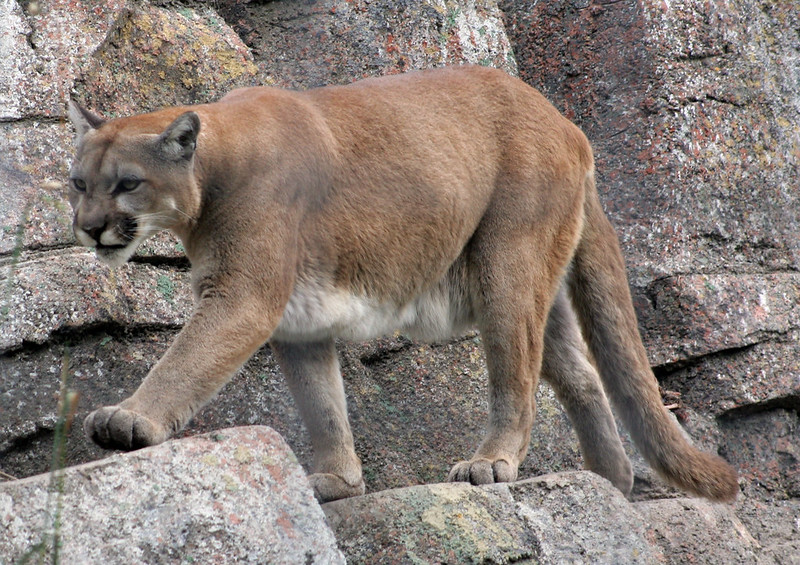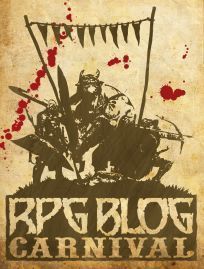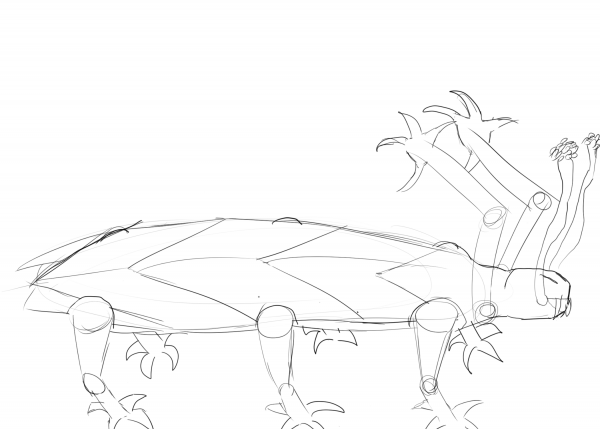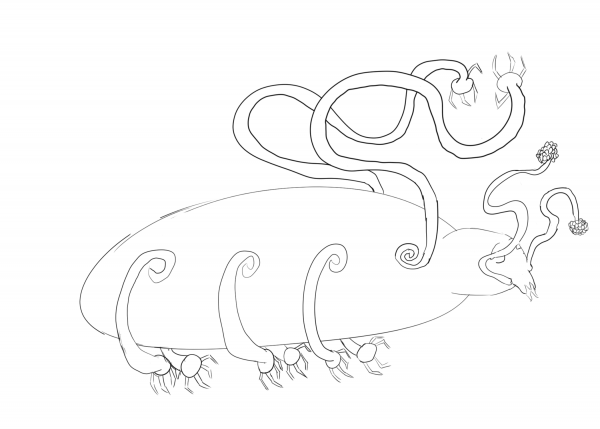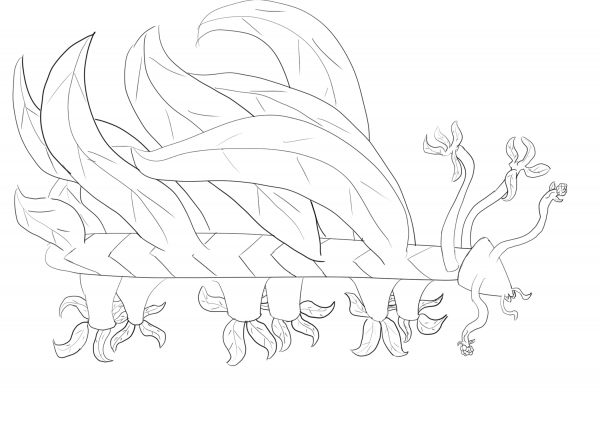The RPG Blog Carnival this month is being hosted by the Enderra Worldbuild & Role-playing Games blog and the topic is Legends and Lore. You can follow that link to find all the other posts people have made on the topic.
When I read this topic, my mind immediately went to the Yazirians in the Star Frontiers setting. They were a natural choice to pursue in greater depth, especially based on much of the fan material that has been developed for that species. And while I’ve been thinking about these ideas for all of the Star Frontiers species, the yazirians are particularly relevant to me right now since part of my Detailed Frontier Timeline (most recent post as of this writing) is currently dealing with a plot line exploring this history directly, namely a ship, the HSS History’s Hope, that is headed toward a system that they think might be Yazira, the yazirian homeworld.
A lot of the foundation for this background is set in two articles that we published in the Star Frontiersman nearly a decade ago in issue 16, back in December 2010. The first is an article written by my friend Tom Verreault entitled “Origin of the Species & the UPF” on page 34 of that issue. In this he gives his version of how the various species in the Frontier got there. The second article, which I wrote to support the ideas he presented for the yazirians in that article, is entitled “Interstellar Interloper (Brown Dwarf)” (p. 46), and discusses what could happen to a planetary system if a brown dwarf sized object passed close through the center of a star system. I recommend you grab issue 16 and read both articles.
This is going to be a two part series. In this first post will look at the background and history of the Yazirian race as I conceive them when running games. The next one will look at the Legends and Lore as it exists at the current point in the campaign. Some of the material is fact, some is common knowledge, some is belief, and some is propaganda. I’ll be looking at it from all those angles.
The Loss of Yazira
The yazirian homeworld, Yazira, orbited a K4 star that is located some 100 light years “west” of the Frontier in an area known as the Vast Expanse, so named because of its low stellar density and large distances between neighboring star systems. Interestingly, very, very few yazirians living today actually know the location of this star system. More on that in the next post. To start let’s go back to about 200 years ago.
It was a time of relative peace and growing industrialization and prosperity for the world. The world had been united under a single government for several centuries and was beginning to develop spaceflight and really start looking into the universe beyond the Yazira system.
A Threat Discovered
It was at this point, as they began to survey the cosmos, that the yazirian astronomers noticed something in the sky that would completely change the course of their specie’s history. When it was first discovered, it was a curiosity. An object extremely bright in the infrared but extremely faint in the visible, even with the yazirian’s definition of visible light that extended somewhat into the infrared. It wasn’t long before a theoretical model was developed for the object, something we today call a brown dwarf.
The astronomers were excited. Based on the observed characteristics, they realized it had to be very close to Yazira. It would allow them to study this type of object up close. As the object was studied more, the distance, a mere 1500 AU, was established.
However, what was also established was that it was coming closer. Over the next few years, the orbit of the object was refined and it was realized that the brown dwarf was falling nearly directly toward their star and would pass very close to their world in the process. Simulations showed that depending on the mass of the object and its exact path, their world and species was in for a major catastrophe ranging from severe and drastic orbital and therefore climate change to complete ejection from their solar system. If something wasn’t done, they were probably doomed as a species.
The bad news was that they were in trouble. The good news was that they had nearly 140 years to prepare. To the Warhon’s credit (the leader of the yazirians), he took the news in stride and neither dismissed it since it wouldn’t happen in his lifetime, nor panicked. Rather he understood the issue for what it was and began charting a course for his people.
The general populace wasn’t so stoic. Many denounced the scientists as alarmists. Others claimed the discovery to be a hoax. Still others used it to as an excuse to hoard survival gear, food, and other essentials and drop out of society. Many just ignored it due to the long time scale. The most troubling, however, were those that took the news to mean that society was over and reverted to lawlessness and anarchy. It was these latter groups that would plague yazirian society for the next century.
A Plan Takes Shape
Over the next decade, as the Warhon’s troops dealt with the anarchists and the astronomers worked to refine the object’s trajectory even more, the government began investing heavily in space technology. While yazirians had already visited their two moons and had many low altitude orbital flights, the extra push from the government allowed them to set foot on other worlds in the system for the first time before the decade was over.
With the development in space technology well under way, the government also started a few other projects. One was increased medical research, especially related to long duration spaceflight and how the yazirian body would adapt and change under different conditions (gravity, stellar flux, etc).
The other was called the Ark Project. This had two areas of focus. The first was to catalog the genomes of every species on the planet, plant and animal, and collect this into a large database as well as collecting samples of as many species as possible. The second was a push into cloning technology that would allow the recreation of those species from the database.
The ultimate goal was to move the yazirian population off of their homeworld to somewhere else. Where was yet to be determined. The initial plan called for the creation of huge generations ships that would travel to likely star systems looking for a world to inhabit. Astronomers had already begun looking for worlds around other suitable stars.
A Change of Plans
Some thirty years after the original identification of the brown dwarf, a discovery occurred that would change the very foundation of what had come to be called the Exodus project.
Using a variety of propulsion technologies, a major break through had been achieved that would allow them to accelerate small probes fast enough to reach some of the nearer star systems before the generations ships would have to leave the Yazira system. The first probes were launched, and as they achieved speeds of about 1% the speed of light, only a fraction of their final velocity, they vanished.
At first it was believed that the probes had broke up or otherwise become inoperable. However, deep radar scans of the region of space they should have been in returned no data. And having five probes, all going different directions, vanish in exactly the same way was more than mere coincidence.
Another set of probes were launched as a test which ended with the exact same result. Yazirian scientists realized that this was some fundamental aspect of physics that they had not suspected or known about. Hundreds of researchers started working on the problem.
It was nearly a decade before a breakthrough was made and a theory of hyperdimensional travel was discovered. In the mean time, work had been going on to improve technology to the point that a crewed vessel could achieve the speeds necessary to invoke the effect.
It would be another decade before a ship was ready to make the first attempt at testing this theory. With a total delta-V of 5% of the speed of light, the ship should be able to achieve the hyperdimenional travel speed, slow down and do it again. Thus is should be able to make a trip and return. In theory.
A Historic Flight
With an all volunteer crew, the YSS Grand Voyager set out on its maiden voyage in an attempt to make history. It took a month of acceleration to get up to near the 1% speed of light threshold and then another agonizing month of small bursts of thrust to precisely measure and cross the threshold. Then just like the the probes, the Grand Voyager vanished.
It would be months of anxious waiting before the fate of the Grand Voyager would be learned. Most people had given up hope when a faint radio signal was received from the ship coming from high out of the orbital plane of the system. They had survived the trip and hyperdimensional travel, which would come to be called Void travel when they met the other species in the Frontier, was possible. There was still much to learn about this new form of travel, but the travel time for the exodus had been greatly reduced.
Looking for a Place to Call Home
Over the next two decades, propulsion technology was innovated and improved and more and more ships were launched to scout out the nearby star systems looking for a world that they could move the population of Yazira to. Most of these ships would eventually be lost as they explored further and further from Yazira. It was not known if there were troubles with the Void travel, mechanical failures with the ships, or they had suffered misfortune in the systems they visited.
As ships did return, they learned much about the nearby stellar systems but no suitable world was found. Finally, after nearly two more decades of searching, a ship returned from a two year journey reporting that a suitable world had been found, nearly 100 light years away. The star was significantly brighter and yellower than Yazira but the world itself was nearly Yazira’s twin in climate and gravity.
During this time, the designs of the exodus ships were rebuilt from the ground up to use this new mode of faster than light travel. With a destination finally established, exploration ceased and construction began on the first ship, the YSS Yazira’s Ark, that would take a select crew, along with a copy of the genetic archive, to this new world to start preparing it for the arrival of the rest of the population.
The Exodus Begins
It took five years for the YSS Yazira’s Ark to be completed. Crewed primarily by members of Clan Anglann, it departed for the new system which had been dubbed Araks to colonize and begin yaziriforming the planet Hentz.
By this time, the brown dwarf was visible to the unaided eye on Yazira and was year by year growing brighter. The world began to focus almost completely on the construction of the exodus ships. While there were some that decried the damage being done to the environment due to the industrialization of the planet, most understood that the world was doomed and so accepted the changes.
Five years after the YSS Yazira’s Ark left, five more ship were completed with nearly twenty-five more in some stated of completion. These later ships were gigantic, nearly ten times the size of the Yazira’s Ark. It would take nearly two hundred more to move the entire population. With the first five ships complete, the exodus of the yazirian population to Hentz began in earnest.
It had been decided early on that when the time came, ships would be populated by clans. While the crews were often from Clan Anglann, the passengers were drawn from a single clan or possibly two. Depending on the size of the clan, it could take two or three ships to hold the entire clan population.
Over the next two decades, a steady stream of ships departed the Yazira system. Finally, the last ships were completed, three of the giant colony ships and a final, smaller ship modeled on the original Yazira’s Ark. This last ship contained the Royal Court, the Warhon and his family, who was the son of the Warhon who had started the project, 120 years earlier. It also contained a final copy of the genetic database including all the additional data that had been collected since the Yazira’s Ark had left. It was the last ship to leave their doomed world. The interloping brown dwarf was clearly visible in the night sky and only 18 years away. It was the last ship to leave.
Trouble at the Destination
As the second wave of colony ships were arriving at Hentz, the yazirians detected signals from other spacefaring species not too far from their new world. Concerned that they might be hostile, Clan Anglann, which had been organizing the exodus, diverted ships from waves three and four to several new worlds in systems nearby. These ships went to the Athor, Gruna Garu and Scree Fron systems. The worlds there were not as desirable as Hentz, but the yazirians wouldn’t have all their eggs in a single basket if these new species proved to be hostile.
Loss of the Warhon
The trip from Yazira to Araks was a long one requiring nearly twenty Void jumps along the way. As the final fleet of ships made the journey, disaster struck. On the 5th jump, the Warhon’s ship didn’t arrive in the destination system. The other three ships waited for nearly two months but the Warhon never reappeared. Finally, they completed their journey and delivered the news to the yazirians on Hentz and it was related to the others in the Athor, Gruna Garu, and Scree Fron systems.
A week of mourning was held for the Warhon’s family. And then political chaos erupted. With the entire royal family gone, a power vacuum was created. In the end, Clan Anglann and the Family of One, who had been organizing the exodus on behalf of the Warhon, took control of the yazirian government.
Fallout
Many suspected foul play. Of the nearly 250 ships built, only the newest ship with the most up to date technology was unable to make the trip. Coincidentally, it also happened to contain the Warhon and his family. The most vocal opponents of the Family of One’s rule was the Warhon’s personal guard that had arrived in advance. Their voices were quickly surpressed. Many just vanished. Others emigrated to the Prenglar, Cassidine, and Truane’s Star systems, integrating with the other races in the Frontier who the yazirians had established contact with some years before.
It wasn’t too many years later that the sathar first appeared in the Frontier. This effectively put an end to the inter-clan conflict as the species in the Frontier united to fend off his new foe. With the formation of the UPF, the yazirian race started looking forward instead of back. Some still remember the old days but most have accepted the new order and are working toward the future.
Next Time
That represents the history of the Yazirian people as most people know it. There are a few things in that narrative that are not widely known (such as the suppression of dissension by the Family of One, but that information should be familiar to most yazirian characters and many non-yazirians as well.
Next week we’ll look at lots of details behind the scenes and outside the Frontier that impact the store and contribute to the lore of the yazirian species.

